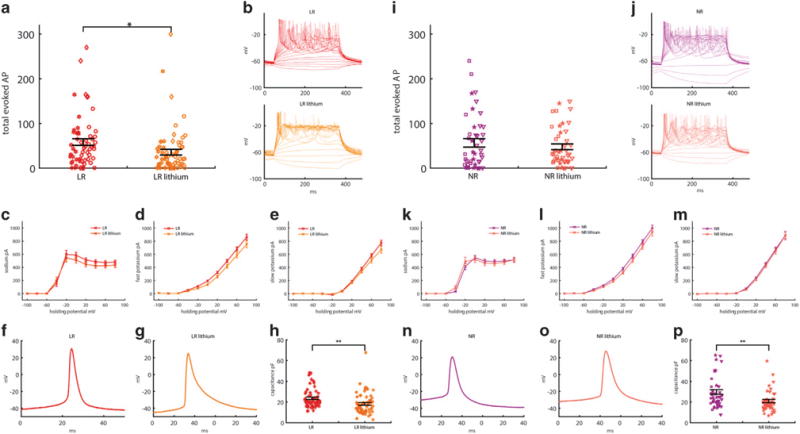Figure 6.

Lithium (Li) decreases the excitability of neurons from Li-responsive (LR) patients (n = 59 neurons from three lines, and n = 67 Li-treated neurons from three lines) but not of neurons from lithium-non-responsive (NR) patients (n = 44 neurons from three lines, and n = 47 neurons from three lines treated with Li). Neurons patched at 22–30 days postdifferentiation. (a–h) Effects of Li on LR neurons. Red represents measurements without Li treatment; orange represents measurements with Li treatment. (a) Total number of evoked action potentials. (b) Representative recording of evoked action potentials in current clamp mode in LR (red) and Li-treated LR (orange) neurons (c–e) Averages of (c) sodium currents recorded in voltage clamp mode, decreased with Li treatment, (d) fast potassium currents, decreased with Li treatment and (e) slow potassium currents, unchanged after treatment. (f and g) A representative trace of an action potential shape of an untreated LR neuron (f) and a Li-treated LR neuron. (g) Li treatment causes broadening of the action potential and a reduction in the fast after-hyperpolarization (AHP) amplitude. See Supplementary Figure 3 for averages. (h) Capacitance decreased after Li treatment. (i–p) Similar analysis of the effect of Li on NR neurons (purple) and Li-treated NR neurons (pink) shows there is no significant decrease in neuronal excitability (i and j). (k–m) No significant differences in the sodium and slow potassium current were displayed. The fast potassium current decreased after treatment. (n and o) Li treatment caused a reduction in fast AHP amplitude and a shift towards a less depolarized threshold for evoking an action potential; see Supplementary Figure 3 for averages. (p) Similar to LR neurons, capacitance was reduced with Li treatment in NR neurons. Identical symbols indicate cells from the same cell line. *P<0.05 and **P<0.01.
